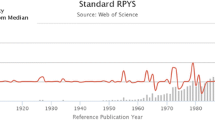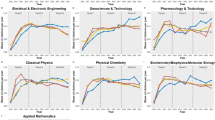Abstract
With the study on 2,217,047 references of 280,280 source articles in Chinese Social Science Citation Index in year 2006–2008, we discovered the overall aging phenomenon of humanities and social sciences by means of synchronous citation analysis, and compared the aging law of seven disciplines. The results reveal that the aging speed of seven disciplines roughly descend as follows: Management, Economics, Education, Law, Literature, Philosophy, History. This is due to the reasons that the aging speed of humanities is slower than social sciences and the dependence of History and Philosophy on archival literature is the strongest. Moreover, each discipline of humanities and social sciences follows a basic function: half life (H) × Price Index (P) = constant C, C is 2.6 or so. Furthermore, the maximum citation age of humanities and social sciences at this stage is found to be about 3 years.






Similar content being viewed by others
References
Barnett, G. A., & Fink, E. L. (2008). Impact of the internet and scholar age distribution on academic citation age. Journal of the American Society for Information Science and Technology, 59(4), 526–534.
Barnett, G. A., Fink, E. L., & Debus, M. B. (1989). A mathematical model of academic citation age. Communication Research, 16, 510–531.
Bernal, J. D. (1958). The transmission of scientific information: A user’s agenda. In Proceedings of the international conference on scientific information, November 1–21 (pp. 77–95). National Academy of Sciences—National Research Council, Washington, DC.
Burghes, D. N., & Wood, A. D. (1980). Mathematical models in the social management and life sciences. New York: Wiley.
Burton, R. E., & Kebler, R. W. (1960). The “half-life” of some scientific and technical literatures. American Documentation, 11, 18–22.
Chen, L. X., Liang, L. M., & Liu, Z. Y. (2006). The variation trend of aging rate of literature for mechanics during 50 years (1954–2003). Modern Information, 10, 12–18.
Chen, L. X., & Liu, Z. Y. (2007). Research on quantitative relationship between half-life and price index of citations. Document, Information & Knowledge, 1, 25–28.
Clark, C. V. (1976). Obsolescence of the patent literature. Journal of Documentation, 32(1), 32–52.
Cunningham, S. J., & Bocock, D. (1995). Obsolescence of computing literature. Scientometrics, 34(2), 255–262.
Diodato, V., & Smith, F. (1993). Obsolescence of music literature. Journal of the American Society for Information Science, 44(2), 101–112.
Editorial Board. (1979). Ci Hai, an unabridged, comprehensive dictionary. Shanghai: Lexicographical Publishing House.
Egghe, L. (1993). On the influence of growth on obsolescence. Scientometrics, 2, 195–214.
Egghe, L. (1997). Price index and its relation to the mean and median reference age. Journal of the American Society for Information Science, 6, 564–573.
Feng, Q., & Chen, Q. (1999). Analysis on citations of periodicals in life science. Journal of the China Society for Scientific and Technical Information, 18(6), 283–286.
Glänzel, W., & Schoepflin, U. (1995). A bibliometric study on ageing and reception processes of scientific literature. Journal of Information Science, 21(1), 37–53.
Glänzel, W., & Schoepflin, U. (1999). A bibliometric study of reference literature in the sciences and social sciences. Information Processing and Management, 35(1), 31–44.
Gosnell, C. F. (1943). The rate of obsolescence in college library book collections by an analysis of three select lists of books for college libraries. New York: New York University.
Gupta, U. (1990). Obsolescence of physics literature: Exponential decrease of the density of citations to physical review articles with age. Journal of the American Society for Information Science, 41(4), 282–287.
Gupta, B. M. (1998). Growth and obsolescence of literature in theoretical population genetics. Scientometrics, 42(3), 335–347.
He, Z. W. (1989). A pseudo problem in historical study—Speaking of the so-called secular-stagnation thesis of Chinese feudal society. Encyclopedic Knowledge, 5, 23–30.
He, Z. W. (1998). An essay on academic culture by He Zhaowu (pp. 200–207). Beijing: China Youth Publishing Group.
Institute for Information of Social Sciences in Chinese Academy of Social Sciences. (1985). Handbook on contemporary social sciences in foreign countries. Nanjing: Jiangsu People’s Publishing House.
Li, X. (2009). Research on half-life of literature in materials science. Journal of Wuhan University of Technology, 31(1), 153–158.
Line, M. B. (1974). Does physics literature obsolesce? A study of variation of citation frequency with time for individual journal articles in physics. BLL Review, 2(3), 84–91.
Longyear, R. M. (1977). Article citations and “obsolescence” in musicological journals. The Quarterly Journal of the Music Library Association, 33(3), 563–571.
Ma, F. C., & Xia, Y. H. (2009). An empirical study on life cycle of network information. Information Studies: Theory & Application, 6, 1–4.
O’Reilly, W. J. (1972). Pharmacokinetics in drug metabolism and toxicology. Canadian Journal of Pharmaceutical Sciences, 7, 66–77.
Portmann, G. A. (1970). Pharmacokinetics. In J. Swarbrick (Ed.), Current concepts in the pharmaceutical sciences: Biopharmaceutics (pp. 1–56). Philadelphia: Lea & Febiger.
Price, D. J. (1970). Citation measure of hard science: Soft science, technology and nonscience. In Nelson C. E. & Pollock D. K.(Eds.), Communication among Scientists and Engineers (pp. 3–22). Lexington, MA: D.C. Heath and Company
Qiu, J. P., et al. (2007). Informetrics. Wuhan: Wuhan University Press.
Sandison, A. (1974). Densities of use, and absence of obsolescence, in physics journals at MIT. Journal of the American Society for Information Science, 25(3), 172–182.
Sangam, S. L. (1999). Obsolescence of literature in the field of psychology. Scientometrics, 44(1), 33–44.
Simon, W. (1972). Mathematical techniques for physiology and medicine. New York: Academic Press.
Tsay, M.-Y. (1998). Library journal use and citation half-life in medical science. Journal of the American Society for Information Science, 49(14), 1283–1292.
Wallace, D. P. (1986). The relationship between journal productivity and obsolescence. Journal of the American Society for Information Science, 3, 136–145.
Wang, C. D. (1997). An introduction to bibliometrics (pp. 346–350). Guilin: Guangxi Normal University Press.
Wang, C. X. (2004). The aging rate of literature in computer science. Shanxi Library Journal, 3, 4–8.
Wang, Y. C. (2009). The empirical study and application of aging law of books collections. Journal of Information, 28(3), 50–54.
Zhang, M. C. (1999). A review on research on relations of humanities and social sciences. Philosophical Trends, 6, 26–29.
Zhang, Y. F. (2008). The cited half-life of journals of Chinese statistical source of medical technology in 2005. Chinese Journal of Medical Library and Information Science, 17(4), 75–80.
Acknowledgments
This study was funded in part by the National Social Science Fund of China (No. 13CTQ036), and was sponsored by Zhejiang Provincial Key Research Base of Humanistic and Social Sciences in Hangzhou Dianzi University (ZD04-201401). It was sponsored by the Research center of information technology and economic and social development.
Author information
Authors and Affiliations
Corresponding author
Appendix
Appendix
Rights and permissions
About this article
Cite this article
Song, Y., Ma, F. & Yang, S. Comparative study on the obsolescence of humanities and social sciences in China: under the new situation of web. Scientometrics 102, 365–388 (2015). https://doi.org/10.1007/s11192-014-1410-8
Received:
Published:
Issue Date:
DOI: https://doi.org/10.1007/s11192-014-1410-8




